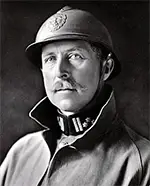King Albert I of Belgium
Albert I was King of Belgium for more than two decades in the first half of the 20th Century, most notably enduring an occupation by Germany during World War I. He was born on April 8, 1875, in Brussels. His father was Prince Philippe, Count of Flanders, and his mother was Princess Marie of Hohenzollern-Sigmaringen. The reigning monarch at the time was Leopold II. Young Albert grew up at court and became second in line to the throne after his older brother, Baudouin, died. In order to prepare for the eventuality that he inherited the throne, he made an effort to get to know how people less fortunate than he was lived. He dressed the part and traveled around the country without being recognized, observing the cares and challenges of the population at large. He also, after his grandfather gave up control of the Congo Free State and it became the Belgian Congo, toured the colony, there also observing living conditions. In 1900, Albert married Elisabeth Gabrielle Valérie Marie of Bavaria. They had three children: Leopold (1901), Charles (1903), and Marie-José (1906). Albert's father died in 1905, making Albert the heir apparent, When Leopold II died, on Dec. 23, 1909, Albert became king. He made a point of instituting reforms in the Belgian Congo. 
In the system of entangling alliances that had led in part to various declarations of war during World War I, Belgium counted on support from France and the U.K., signatories of an 1839 treaty that guaranteed Belgian neutrality and other powers' support for that neutrality. When Germany refused to respect Albert's desire to remain neutral, the resulting invasion resulted in entries into the war by France and the U.K. The German leader, Kaiser Wilhelm II, had asked Albert for safe passage for German troops through Belgium as part of an attack on France; Albert had refused. When the Germans advanced across a wide swath of Belgium in August 1914, Albert took command of his troops and fought alongside them in engagement after engagement, in effect fighting a series of rearguard actions that saw the Belgian army holed up behind the Yser River for many months. (He had introduced general military conscription only the year before, but the German army was much larger and much more well equipped.) Albert was in the trenches right along with his soldiers, and his wife, Elisabeth, served as a nurse on the front lines. Their son, Leopold, all of 12, enlisted and fought as well. It was Albert who led the offensive that liberated his country at the end of the war. (The king had tried to get both sides to agree to a negotiated peace, but neither side would.) In the wake of the devastation wrought by the armies of other countries, Albert sought to rebuild his nation and his people's confidence. He championed universal suffrage for men and won out in the end, endorsing as well a coalition government made up of members of Belgium's three main political parties, the Catholics, the Liberals, and the Socialists. Albert represented Belgium at the Paris Peace Conference, meeting with leaders of France, the U.K., and the United States to discuss how to resolve resentment against Germany. Albert warned against a treaty that humiliated Germany and placed very harsh terms on the defeated nation. Other European leaders ignored his warning, slapping devastatingly harsh terms on Germany and forcing its representatives to accept them. Thus rebuffed, Albert made rebuilding his country a priority. He granted protection and freedoms to trade unions and established the National Scientific Research Fund. He also traveled to the U.S., receiving an honorary degree from Columbia University and being the focus of a ticker tape parade in New York City. He found time during championing recovery efforts to found African's first national park, Albert National Park, in the Belgian Congo in 1925. A passionate outdoorsman, Albert fell to his death while mountain climbing in the Ardennes on Feb. 17, 1934. His oldest son succeeded him as King Leopold III. |
|
Social Studies for Kids
copyright 2002–2024
David White




